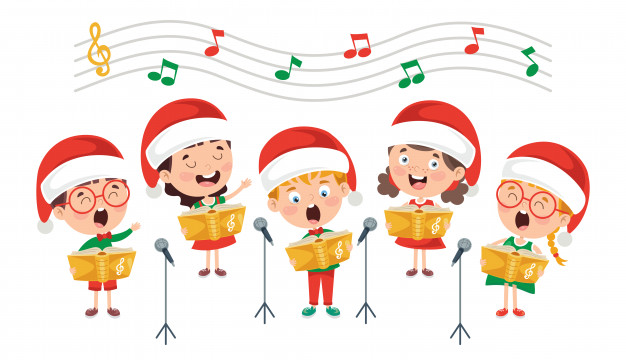10 popular Christmas songs for kids to learn English
>> Your family can enjoy Christmas carols and songs introduced in this article here.
Jingle Bells
Jingle Bells is one of the best known and loved Christmas songs in the world. But do you know this Christmas song was originally written for… Thanksgiving? The song was written by James Lord Pierpont and was copyrighted on September 16, 1857, with the title One Horse Open Sleigh. Jingle Bells was also the first song ever played in outer space.
>> Parents can download and print the words of the song here, or find a short version that is perfect for primary children offered by Bogglesworld.
We Wish You a Merry Christmas
We Wish You a Merry Christmas is said to come from the West of England in the 16th century, and has stood the test of time and remains a viral Christmas song to this very day. The music reflects the Christmas tradition of showering gifts on the people who wandered from house to house, singing Christmas carols.
>> Download the lyrics here.
Silent Night
The world’s most famous Christmas song, Silent Night, comes to us from Austria. It was first performed on Christmas Eve 1818 at St. Nikola Church in the village of Oberndorf. The legend says that a hungry mouse damaged the organ a few days before Christmas. And that in just a few hour’s time, Josef Mohr (priest) and his friend Franz Gruber (organist) produced the song for just two voices and guitar. This beautiful melody is now sung around the world in over 300 languages and dialects.
There is another legendary story about Silent Night: By December 1914, World War I was raging — but along the Western Front, a miraculous thing happened: in the week leading up to Christmas, British, French, and German soldiers laid down their arms, crossed into each other’s trenches, played games and exchanged gifts. They also sang songs — one of which was reportedly Silent Night, which, by that time, would have been familiar to most of the soldiers, even if it was sung in different languages. Parents can tell your child this inspiring story to let them feel the warmth and wonder of Christmas.
>> Download the lyrics here and find a shortlist of the vocabulary of Silent Nights on About.com.
Auld Lang Syne
Auld Lang Syne was a Scottish folk song from the 1600s or earlier. Around 1788, Scottish poet Robert Burns wrote his version, which is the one we know today (with many fun Scottish words, for example, “fiere” means friend). The song became so popular in Scotland that Scottish immigrants sang it wherever they went, spreading the song worldwide. Many people used to call this song Old long ago; that means the same thing. Auld Lang Syne is sung for New Year’s Eve around the world, especially in English-speaking countries. It can be sung all year (at graduations, for example) but is definitely most popular around Christmas time.
>> Download the lyrics here
Deck the halls
The music to Deck the Halls comes from Wales, possibly from the 16th century. The fa-la-la refrains were probably originally played on the harp. In the 18th century, the melody spread widely across Europe. Even Mozart used it in his piano and violin composition, commonly identified as Sonata No. 18. The English words generally sung today are American in origin. The first publication date of Deck the Halls is 1881, yet we don’t know who the author of this jolly song is.
>> Download the lyrics here
Rudolph the Red-Nosed Reindeer
Who can name all of Santa’s reindeer? Few probably can, but there’s one name that stands out among young and old: Rudolph. Rudolph the Red-Nosed Reindeer is a fictional reindeer created by Robert Lewis May. Rudolph is usually depicted as the ninth and youngest of Santa Claus’s reindeer, using his luminous red nose to lead the reindeer team and guide Santa’s sleigh on Christmas Eve. Though he initially receives ridicule for his nose as a fawn, his nose’s brightness is so powerful that it illuminates the team’s path through harsh winter weather. Not only cheerful and fun-to-sing, but this song also carries a meaningful lesson about embracing diversity because no one should ever feel left out or treated poorly simply for being a little different.
>> Lyrics are available at About.com and don’t forget to try the activities recommended at ESLKidStuff. There’s a pin the tail on the reindeer game that is sure to provide lots of holiday fun for the little ones.
Frosty the Snowman
Inspired by the massive success of the single Rudolph the Red-Nosed Reindeer recorded by Gene Autry, Jack Rollins, and Steve Nelson wrote Frosty the Snowman in 1950. Despite being a viral Christmas song, Frosty the Snowman doesn’t contain the word Christmas in its lyrics. Frosty became a magical holiday icon, whose story was told over and over in the form of books, films, and additional recordings.
>> Download the lyrics here
Let it snow
“Let It Snow! Let It Snow! Let It Snow!”, also known simply as “Let It Snow,” is a song written by lyricist Sammy Cahn and composer Jule Styne in July 1945. Although this song is associated with Christmas, there is no mention of the holiday in the lyrics. It’s about making the most of a snowy day by spending it with a loved one by the fire. The song has come to be regarded as a Christmas song in North America due to its winter theme, being played on radio stations during the Christmas and holiday season, and having been covered by various artists on Christmas-themed albums.
>> Download the lyrics here
Santa Claus is comin’ to town
Santa Claus is comin’ to town is a Christmas song written by J. Fred Coots and Haven Gillespie and first sung on Eddie Cantor’s radio show in November 1934. It became an instant hit with orders for 100,000 copies of sheet music the next day and more than 400,000 copies sold by Christmas. It is regularly used to tell children that Santa Claus knows when they’ve been bad or good and that they should be good.
>> Download the lyrics here
Little Drummer Boy
“The Little Drummer Boy” (originally known as “Carol of the Drum”) is a popular Christmas song written by the American classical music composer and teacher Katherine Kennicott Davis in 1941. First recorded in 1951 by the Trapp Family Singers, the song was further popularized by a 1958 recording by the Harry Simeone Chorale; the Simeone version was re-released successfully for several years and the song has been recorded many times since. The story in the song is about a little boy who hasn’t got a present for baby Jesus, but ‘to honor him’ he plays his drums for him: “I played my best for Him!” and for that, he gets Mary’s approval, and “He smiled at me.”
>> Download the lyrics here
How to choose good songs for learning
The best learning happens when we have fun. So it’s imperative to choose music that your child likes. The best themes for learning English are:
- not too long (1–3 verses)
- not too fast (easy to sing along)
- in everyday English (not too many new or challenging words)
- clear (you can easily hear all the words).
If you have a child that falls into the 5-12-year-old age range, let’s choose songs with lots of rhyming words and rhythms that repeat. This makes it easier for children to learn new words and start singing along. For teenagers, learning through songs is an excellent opportunity to combine their interests and learning the language. If your child is interested in a piece of music, they will be eager to understand it. Singing along can be challenging, even for native speakers. So help your child with these easy steps:
- Print out the lyrics, or find a music video with subtitles.
- Read the song lyrics out loud. Lookup any unknown words in a dictionary. To teach your child new words about Christmas, parents can also try these topic-based worksheets and word games to learn and practice Christmas words: angel, ball, bell, chain, Christmas tree, elf, gingerbread, holly, present, Santa Claus, star, stocking.
- Listen to the song and read the lyrics at the same time. Encourage your child to sing along.
- When they’re ready, try singing along without looking at the lyrics.
- Remember, they don’t have to get it perfect straight away! It’s more effective to repeat regularly.
Some children find it hard to speak English because they are shy or lack confidence. Singing with other people can help. It creates a safe space for children to practice expressing themselves aloud. Ask other family members to join in when your child sings at home. They don’t have to be musical. They simply need to be enthusiastic!
Singing songs can be a fun starting point to make learning English fun and enjoyable. Some of these songs are great lead-ins for discussion, and others are simply fun to sing. Whether you make your own worksheets or use the available ones, make sure you give your students plenty of new things to learn with these beautiful holiday classics!
Should you have any concerns or any topics you want us to cover, please leave your comments below. You can subscribe to our newsletter to get the latest updates delivered straight to your inbox and find more parenting coverage at https://blog.e2.com.vn/category/parents/
Reference:
https://www.wikipedia.org/
https://www.anglomaniacy.pl/
https://busyteacher.org/3958-top-10-christmas-songs-for-esl-classes.html
https://www.cambridgeenglish.org/learning-english/parents-and-children/information-for-parents/tips-and-advice/learn-english-through-songs/












